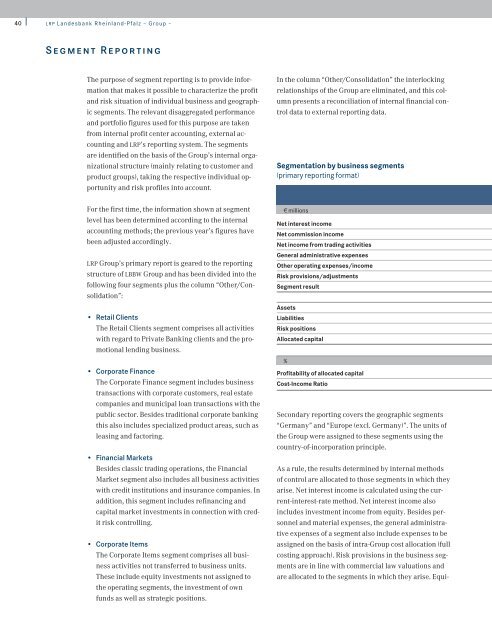Annual Report 2006 - Rheinland Pfalz Bank
Annual Report 2006 - Rheinland Pfalz Bank
Annual Report 2006 - Rheinland Pfalz Bank
You also want an ePaper? Increase the reach of your titles
YUMPU automatically turns print PDFs into web optimized ePapers that Google loves.
40 LRP Landesbank <strong>Rheinland</strong>-<strong>Pfalz</strong> – Group –<br />
Segment <strong>Report</strong>ing<br />
The purpose of segment reporting is to provide information<br />
that makes it possible to characterize the profit<br />
and risk situation of individual business and geographic<br />
segments. The relevant disaggregated performance<br />
and portfolio figures used for this purpose are taken<br />
from internal profit center accounting, external accounting<br />
and LRP’s reporting system. The segments<br />
are identified on the basis of the Group’s internal organizational<br />
structure (mainly relating to customer and<br />
product groups), taking the respective individual opportunity<br />
and risk profiles into account.<br />
In the column “Other/Consolidation” the interlocking<br />
relationships of the Group are eliminated, and this column<br />
presents a reconciliation of internal financial control<br />
data to external reporting data.<br />
Segmentation by business segments<br />
(primary reporting format)<br />
For the first time, the information shown at segment<br />
level has been determined according to the internal<br />
accounting methods; the previous year’s figures have<br />
been adjusted accordingly.<br />
LRP Group’s primary report is geared to the reporting<br />
structure of LBBW Group and has been divided into the<br />
following four segments plus the column “Other/Consolidation”:<br />
• Retail Clients<br />
The Retail Clients segment comprises all activities<br />
with regard to Private <strong>Bank</strong>ing clients and the promotional<br />
lending business.<br />
• Corporate Finance<br />
The Corporate Finance segment includes business<br />
transactions with corporate customers, real estate<br />
companies and municipal loan transactions with the<br />
public sector. Besides traditional corporate banking<br />
this also includes specialized product areas, such as<br />
leasing and factoring.<br />
• Financial Markets<br />
Besides classic trading operations, the Financial<br />
Market segment also includes all business activities<br />
with credit institutions and insurance companies. In<br />
addition, this segment includes refinancing and<br />
capital market investments in connection with credit<br />
risk controlling.<br />
• Corporate Items<br />
The Corporate Items segment comprises all business<br />
activities not transferred to business units.<br />
These include equity investments not assigned to<br />
the operating segments, the investment of own<br />
funds as well as strategic positions.<br />
1 millions<br />
Net interest income<br />
Net commission income<br />
Net income from trading activities<br />
General administrative expenses<br />
Other operating expenses/income<br />
Risk provisions/adjustments<br />
Segment result<br />
Assets<br />
Liabilities<br />
Risk positions<br />
Allocated capital<br />
%<br />
Profitability of allocated capital<br />
Cost-Income Ratio<br />
Secondary reporting covers the geographic segments<br />
“Germany” and “Europe (excl. Germany)”. The units of<br />
the Group were assigned to these segments using the<br />
country-of-incorporation principle.<br />
As a rule, the results determined by internal methods<br />
of control are allocated to those segments in which they<br />
arise. Net interest income is calculated using the current-interest-rate<br />
method. Net interest income also<br />
includes investment income from equity. Besides personnel<br />
and material expenses, the general administrative<br />
expenses of a segment also include expenses to be<br />
assigned on the basis of intra-Group cost allocation (full<br />
costing approach). Risk provisions in the business segments<br />
are in line with commercial law valuations and<br />
are allocated to the segments in which they arise. Equi-
















